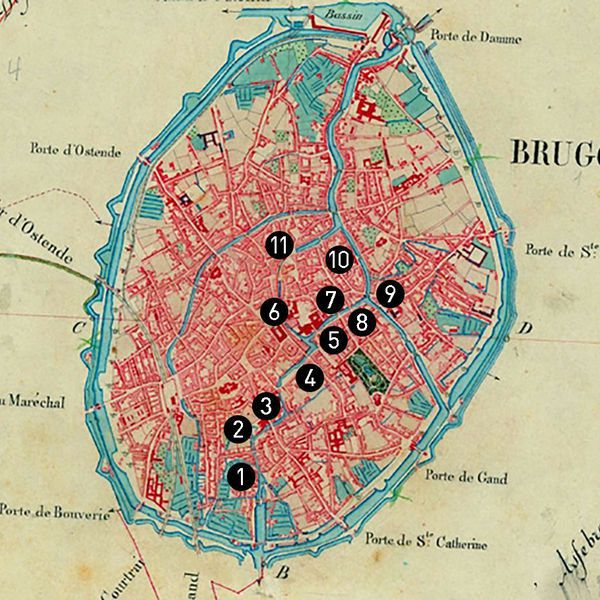
Course
Our course takes you along the most scenic spots in Bruges. You get to see the most famous places of interest from a totaly different perspective. Find more info on some of the historic buildings herebelow.

1. Beguinage
The 'Princely Beguinage Ten Wijngaarde' with its white-coloured house fronts and tranquil convent garden was founded in 1245. This little piece of world heritage was once the home of the beguines, emancipated lay-women who nevertheless led a pious and celibate life. Today the beguinage is inhabited by nuns of the Order of St. Benedict and several Bruges women who have decided to remain unmarried.
READ MORE

2. Saint John’s Hospital
Saint John’s Hospital has an eight hundred-year-old history of caring for pilgrims, travellers, the poor and the sick. Visit the medieval wards where the nuns and monks performed their work of mercy, as well as the chapel, and marvel at the impressive collection of archives, art works, medical instruments and six paintings by Hans Memling. Also worth a visit: the Diksmuide attic, the old dormitory, the adjoining custodian’s room and the pharmacy.
READ MORE

3. Church of Our Lady
The 115.5 metres high brick tower of the Church of Our Lady is a perfect illustration of the craftsmanship of Bruges’ artisans. The church displays a valuable art collection: Michelangelo’s world-famous Madonna and Child, countless paintings, 13th-century painted sepulchres and the tombs of Mary of Burgundy and Charles the Bold.
READ MORE

4. Groeninge Museum
The Groeninge Museum offers a varied overview of the history of Belgian plastic arts. Although the Flemish Primitives are a high point, you will also marvel at top 18th and 19th-century neoclassical pieces, masterpieces from Flemish Expressionism and post-war modern art.
READ MORE

5. Ambachtshuis Huidevetters

6. Belfry & Carillon
The most important of Bruges’ towers stands 83 metres tall. It houses, amongst other things, a carillon with 47 melodious bells. Those who take on the challenge of climbing the tower can pause for a breather on the way up in the old treasury, where the city’s charters, seal and public funds were kept during the Middle Ages, and also at the level of the impressive clock or in the carillonneur’s chamber. Finally, after a tiring 366 steps, your efforts will be rewarded with a breath-taking and unforgettable panoramic view of Bruges and her surroundings.
READ MORE

7. Liberty of Bruges
From this mansion, the countryside in a wide area around the city was once governed. The building functioned as a court of justice between 1795 and 1984. Today the city archives are stored here. They safeguard Bruges’ written memory. The premises also boast an old assize court and a renaissance hall with a monumental 16th-century timber, marble and alabaster fireplace made by Lanceloot Blondeel.
READ MORE

8. Fish Market
At first, fish was sold on one of the Markt’s corners, but as the townspeople complained about the stench, the fishmongers were forced to move and sell their wares here. In the covered arcade (1821), specially erected for the purpose of selling fish, fresh seafish was sold, a delicacy that only the rich could afford. Today you can still buy your fresh saltwater fish here every morning from Tuesday to Saturday.
READ MORE

9. Almshouses
Many small, whitewashed almshouses can be seen in the townscape of Bruges, mostly clustered around a cosy courtyard. These precursors of public housing were established in de 14th century by wealthy townspeople or guilds. They housed poor elderly people or widows. More than 46 blocks of almshouses have been preserved, scattered over the city, 43 of which are still occupied by elderly people.
READ MORE

10. Stepped gables

11. Burghers' Lodge
Right on the corner of Jan Van Eyckplein there is a striking building with a dramatic tower. The Poortersloge (Burgher’s Lodge) was built towards the end of the 14th century and the start of the 15th century and served as a meeting spot for the Genootschap van de Witte Beer (Society of the White Bear), a society of burghers. The leading burghers received traders in the lodge so that business matters could be settled in a relaxed atmosphere. It was a perfect location, as it was where the trading vessels moored before clearing their goods and was also close to the foreign-owned warehouses. The building served as the city’s Academy of Arts between 1720 and 1890, after which it did duty as the State Archives from 1912 to 2012.